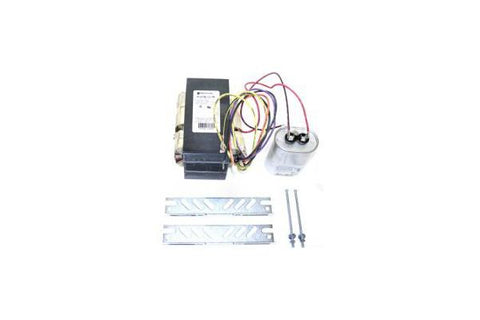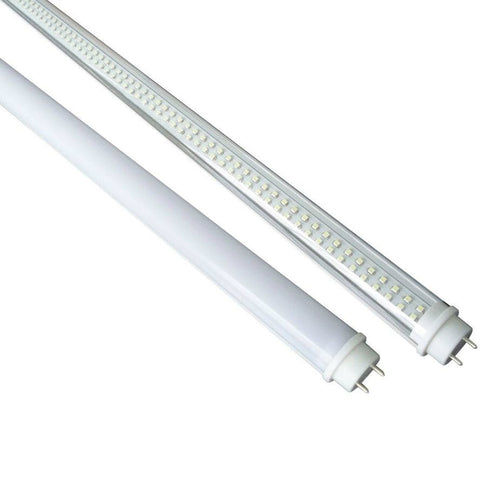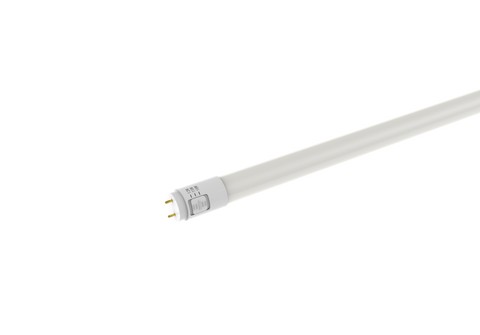What is a Ballast?
A ballast is a device that sits between your power source and your fluorescent light fixture. Its job is to protect the fluorescent bulbs by controlling the flow of electrical current into the fixture. Since fluorescent bulbs cannot regulate current on their own, without a ballast, the bulbs can draw too much power and burn out. In addition to significantly shortening the lifespan of the bulb, this can create a safety hazard.
- Do LED Lights Need Ballasts? An LED light does not require a ballast because it uses a component called a “driver” to regulate the power going into the bulb.
- Do I Have to Remove Ballasts to Use LED Bulbs? This depends on the bulbs. Some LED bulbs may require you to remove the ballasts. However, a high-quality plug and play LED tube - like Warehouse Lighting’s Triple-Fit 4’ T8 LED – can be used in direct wire fixtures as well as traditional fluorescent fixtures with ballasts. In other words, thanks to its flexibility, you use a plug and play LED without ballasts or with.
What are Plug and Play LED Tubes?
Plug and play LED tubes are shaped just like fluorescent bulbs and connect to the fixture the same way. Since plug and play LEDs are compatible with ballasts, you can simply remove a fluorescent bulb and replace it with an LED. Since no additional modification or wiring is required, it’s as easy as replacing incandescent bulbs with LED bulbs in your home.
- What is a Ballast Bypass? A ballast bypass is when you remove a ballast from the electrical circuit that goes to your light fixture. Since the ballast sits between your power source and the light fixture, this means either removing the ballast completely or simply disconnecting the ballast and wiring the light fixture straight into the power source. You can learn how to bypass a ballast here.
Pros and Cons of Keeping the Ballasts (Plug and Play)
PROS
- It’s the easiest solution (no wiring or modification is required).
- You still have the option to use fluorescent bulbs.
- The ballasts, while not technically necessary, may provide an additional level of protection to the light fixtures.
CONS
- The ballasts will eventually wear out and need removal or replacement.
- Some lighting experts believe LEDs provide better light and are more efficient when the ballasts are removed.
Pros and Cons of Removing the Ballasts (Ballast Bypass)
PROS
- There are fewer components to wear out and require replacement.
- Some lighting experts believe LEDs provide better light and are more efficient when the ballasts are removed.
CONS
- Rewiring of the fixtures is required.
- You can no longer use fluorescent bulbs in the fixtures.
- You have to be careful fluorescent bulbs are not used, as this can pose a safety issue.
- The ballasts, while not technically necessary, may provide an additional level of protection to the light fixtures.
When to Choose Plug and Play vs. Ballast Bypass
Each LED upgrade method has specific scenarios where it makes the most sense. Below is a guide to help businesses determine the best solution based on their needs.
When Plug and Play is the Best Option
- Quick fix: No need for rewiring or electrical work.
- Temporary lighting solutions: If you plan to upgrade fixtures later, this is an easy way to transition to LED.
- Ballast-required industries: Some industries require ballasts for regulatory reasons or compatibility with existing controls.
- Fluorescent backup flexibility: If you may still use fluorescent bulbs in the future, plug and play LEDs allow for dual compatibility.
When Ballast Bypass is the Best Option
- Maximizing energy efficiency: Eliminates ballast energy consumption, reducing long-term electricity costs.
- Long-term reliability: Fewer components mean fewer failure points, extending lifespan.
- Older facilities: If your ballasts are already failing or outdated, it's cheaper to bypass them now.
- Smart lighting integration: Ballast-free LED tubes can be used with dimmers, sensors, and smart control systems for better efficiency.
Plug and Play vs. Ballast Bypass Comparison
|
Feature |
Plug and Play LED |
Ballast Bypass LED |
|
Installation |
Simple installation, no rewiring needed. |
Requires rewiring and ballast removal |
|
Cost |
Lower upfront cost, but higher long-term cost due to ballast replacements. |
Higher upfront cost due to labor, but lower long-term cost with no ballast replacements. |
|
Lifespan |
Dependent on ballast lifespan; LEDs last longer, but ballasts may fail. |
Longer lifespan—fewer failure points since ballasts are eliminated. |
|
Maintenance |
Requires periodic ballast maintenance and potential replacement. |
Minimal maintenance—no ballasts to replace. |
|
Energy Efficiency |
Slightly less efficient due to power consumption from ballast. |
More efficient—no energy lost to ballast, direct power to LEDs. |
|
Uses |
Best for quick upgrades, temporary lighting, or locations where fluorescent compatibility is needed. |
Best for long-term savings, older buildings, or facilities transitioning fully to LED. |
Shop Warehouse-Lighting.com for T8 LED Plug and Play Lamps
Warehouse Lighting offers the perfect durable, long-lasting, and energy-efficient upgrade from fluorescent T8 bulbs. They come in multiple wattages, are shatterproof, and you can use them with ballasts or without. Contact us with any questions you may have about LED upgrades or any other products from Warehouse-Lighting.com.
SHOP LED PLUG & PLAY LAMPSTrending on the Blog
There’s more to light switches than simply “on” and “off.” We’ll walk you through the various types of switches so you know the right ones to choose for your next lighting installation.
Tall ceilings require a specific type of light fixture. Let us “shed some light” on the three main variations, as well as some basic installation guidelines to ensure a safe, well-illuminated environment.
Knowing that one points up and one points down is the easy part. Understanding the “where” and “why” to install an uplight or downlight is key to creating a balanced, pleasing work or living space.

How to Bypass a Ballast to Install LED Tubes
Follow these steps to learn how to bypass a ballast. We break down the risks as well as the steps to help you complete the task.
Read Article High Bay LED Lighting
High Bay LED Lighting
 Industrial Low Bay Lighting
Industrial Low Bay Lighting
 Industrial Strip Lights
Industrial Strip Lights
 Vapor Tight Lighting
Vapor Tight Lighting
 LED Shop Lights
LED Shop Lights
 Hazardous Area / Explosion Proof Lighting
Hazardous Area / Explosion Proof Lighting
 Loading Dock Lights
Loading Dock Lights
 Construction / Portable Lighting
Construction / Portable Lighting
 High Temperature LED Lights
High Temperature LED Lights
 Industrial Ceiling Fans
Industrial Ceiling Fans
 LED Work Lights
LED Work Lights
 Networked Controlled Lighting
Networked Controlled Lighting
 NEW Warehouse Lighting Fixtures
NEW Warehouse Lighting Fixtures
 American Made Industrial Lighting
American Made Industrial Lighting
 Clearance
Clearance
 Troffer Lights
Troffer Lights
 LED Flat Panel Lights
LED Flat Panel Lights
 Drop Ceiling Lights
Drop Ceiling Lights
 Suspended LED Lights
Suspended LED Lights
 LED Cylinder Lights
LED Cylinder Lights
 Exit / Emergency
Exit / Emergency
 Wrap Lighting Fixtures
Wrap Lighting Fixtures
 Gooseneck and Barn Lights
Gooseneck and Barn Lights
 Stairway & Corridor Lighting
Stairway & Corridor Lighting
 Hospital Bed Lights
Hospital Bed Lights
 Recessed Lighting
Recessed Lighting
 Wafer Lighting
Wafer Lighting
 RGB LED Lights
RGB LED Lights
 Grow Lights
Grow Lights
 Refrigeration Lighting
Refrigeration Lighting
 Commercial Sign Lights
Commercial Sign Lights
 LED Track Lighting Fixtures & Systems
LED Track Lighting Fixtures & Systems
 UV Disinfecting Lights & Air Purifier Fixtures
UV Disinfecting Lights & Air Purifier Fixtures
 American Made Commercial Lighting
American Made Commercial Lighting
 LED Flood Lights
LED Flood Lights
 Outdoor Wall Lights
Outdoor Wall Lights
 LED Area Lights
LED Area Lights
 Parking Lot Lights & Poles
Parking Lot Lights & Poles
 Outdoor Post Top Lights
Outdoor Post Top Lights
 LED Stadium Lighting
LED Stadium Lighting
 Canopy Lights
Canopy Lights
 Security & Motion Sensor Lights
Security & Motion Sensor Lights
 LED Bollard Lights
LED Bollard Lights
 Outdoor LED Linear Light Fixtures
Outdoor LED Linear Light Fixtures
 Solar Powered LED Lighting
Solar Powered LED Lighting
 Dusk to Dawn Lights
Dusk to Dawn Lights
 Landscape Lighting
Landscape Lighting
 Outdoor String Lights
Outdoor String Lights
 Coastal Wildlife Lighting
Coastal Wildlife Lighting
 Outdoor House Lights
Outdoor House Lights
 American Made Outdoor Lighting
American Made Outdoor Lighting
 Architectural Linear Lights
Architectural Linear Lights
 Architectural Grid Mount Lights
Architectural Grid Mount Lights
 Architectural Round Pendant Lights
Architectural Round Pendant Lights
 Architectural Square Linear Lights
Architectural Square Linear Lights
 Architectural X-Shaped Linear Lights
Architectural X-Shaped Linear Lights
 Architectural LED Wall Packs
Architectural LED Wall Packs
 Ceiling Fans
Ceiling Fans
 Ceiling Lights
Ceiling Lights
 Chandelier Lights
Chandelier Lights
 Pendant Lighting
Pendant Lighting
 Island Lights
Island Lights
 Under Cabinet Lighting
Under Cabinet Lighting
 Vanity Lights
Vanity Lights
 Wall Sconces
Wall Sconces
 LED Tape Lights
LED Tape Lights
 LED Mirrors
LED Mirrors
 LED Light Bulbs
LED Light Bulbs
 LED Tube Lights
LED Tube Lights
 LED Corn Lights
LED Corn Lights
 Vintage LED Bulbs
Vintage LED Bulbs
 Decorative LED Bulbs
Decorative LED Bulbs
 Fluorescent Light Bulbs
Fluorescent Light Bulbs
 Metal Halide Lamps
Metal Halide Lamps
 LED Magnetic Strip Retrofit Kits
LED Magnetic Strip Retrofit Kits
 LED Strip Light Retrofit Kits
LED Strip Light Retrofit Kits
 High Bay LED Retrofit Kits
High Bay LED Retrofit Kits
 LED Troffer Retrofit Kits
LED Troffer Retrofit Kits
 LED Wall Pack Retrofit
LED Wall Pack Retrofit
 LED Street Light Retrofit Kits
LED Street Light Retrofit Kits
 Recessed Lighting LED Retrofit Kits
Recessed Lighting LED Retrofit Kits
 Ballasts & Drivers
Ballasts & Drivers
 Emergency Ballast For LED & Fluorescent Lights
Emergency Ballast For LED & Fluorescent Lights
 Electrical Supplies & Mounting Kits
Electrical Supplies & Mounting Kits
 Electrical Tools
Electrical Tools
 Switches & Receptacles
Switches & Receptacles
 Electrical Power Cords
Electrical Power Cords
 Sensors and Timers
Sensors and Timers
 Smart Home Automation
Smart Home Automation
 High Bay Occupancy Sensors
High Bay Occupancy Sensors
 Electric Vehicle Chargers
Electric Vehicle Chargers
 Hand Dryers
Hand Dryers
 LED Shop Lights
LED Shop Lights
 Garage LED Light Fixtures
Garage LED Light Fixtures
 Office Lights
Office Lights
 Classroom Lights
Classroom Lights
 Church Lights
Church Lights
 Gym Lighting
Gym Lighting
 Factory Lights
Factory Lights
 Hospital Lights
Hospital Lights
 Walkway Lights
Walkway Lights
 Parking Lot Lights
Parking Lot Lights
 Exterior Building Lights
Exterior Building Lights
 Sports Lighting
Sports Lighting
 Airport Lights
Airport Lights
 NSF Rated Lights
NSF Rated Lights
 Restaurant Lights
Restaurant Lights
 Corridor Lights
Corridor Lights
 Barn Lighting
Barn Lighting













